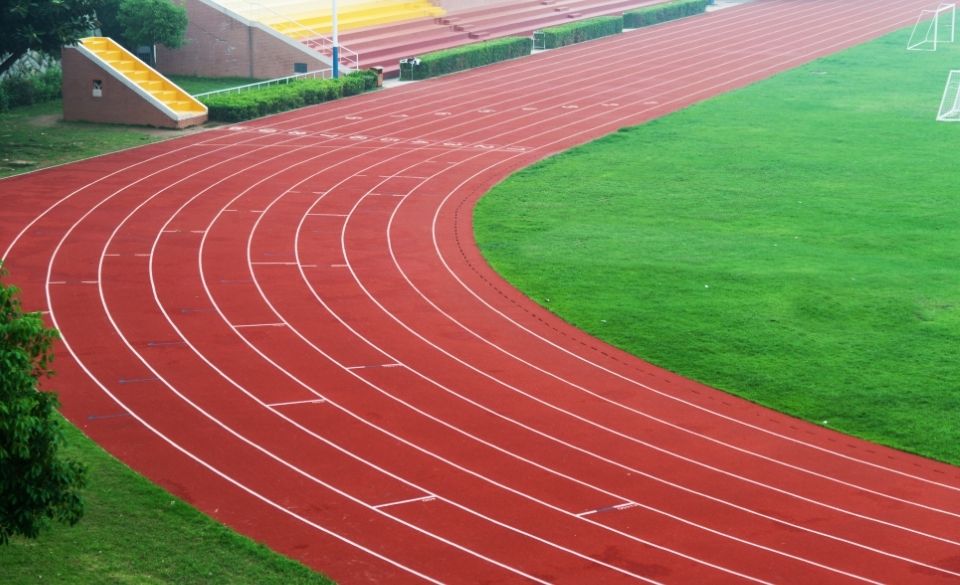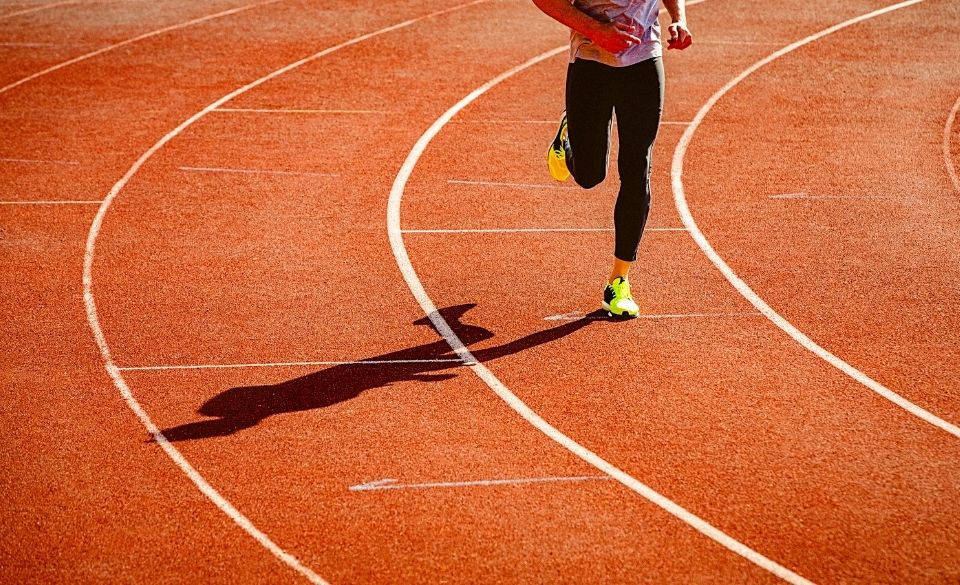
How Many Lanes Are On A Typical Running Track?
Page Contents
If you are new to running, you may not know much about an outdoor running track. However, this shouldn’t deter you. Many new runners know nothing about a running track, let alone what it’s made from. Learning more about a typical running track can help you utilize its benefits of it and may even entice you to use one for your interval sessions, or tempo runs.
In this article we discuss:
– What is a running track made of
– The different types of running track surfaces
– How Many Lanes Are On A Typical Running Track?
– Track Running Etiquette
So, if you want to expand your knowledge of track running and what an outdoor running track is. Keep reading.
What Is A Running Track Made Of?
There are many different types of surfaces used to make a running track. The type of surface used can have a dramatic impact on a runner’s speed and technique of a runner. Because of this, there are many pros and cons of different types of running track surfaces which we explain below.
The most common surfaces used for a running track include natural surfaces like cinder and clay. All-weather surfaces that include asphalt mixed with rubber or sand. And synthetic surfaces, use a mixture of latex or polyurethane surface and asphalt.
Natural running track surfaces
A running track made from natural surfaces usually combines cinder and clay. However, occasionally they may include grass.
These are the most commonly used natural track surfaces. These track surfaces are relatively cheap to construct and are very comfortable to run on. This is because they provide minimal impact to a runner’s joints and provide excellent cushioning, which can help reduce injuries.
However, these surfaces often create more resistance than other running track surfaces. So, it makes the runner’s legs work harder and increase the heart rate much more than on other surfaces. However, they do provide the added benefit of strengthening the foot muscles and can help improve technique.
Despite their benefits, they do have two major disadvantages. These include:
Weather conditions can make them unstable and unusable after rain.
They require constant maintenance and are costly to keep in top condition.
However, in recent years, these types of surfaces have improved. That means they can hold water better and require less maintenance. Yet, the cost of materials on the rise and transportation costs make these types of surfaces unviable to build. Hence why they are rarely constructed today.
All-Weather Surfaces
One of the first modern track surfaces, the all0weather surface has been around since the later 1960s. They are constructed using a combination of asphalt and rubber or sand.
These types of running tracks are relatively unaffected by wet weather conditions. They also provide the runner with a fast surface. However, these surfaces are rarely used as the material cost and surface unpredictability outweigh the positives.
Although many of these tracks are still in use around the world, there is a good reason why they are no longer produced at the same rate as before. This is because:
-They are easily affected by temperature changes (hot in summer, hard in winter)
– The asphalt ages and loses resilience.
– Can increase the impact on a runner’s joints and muscles, increasing the chances of injury.
– Cost of asphalt has risen.
Synthetic Surfaces
The most common surface used today. Synthetic surfaces are built using a mixture of rubber particles bound with latex or polyurethane. This provides the runner with a fast surface to run on and a surface that is resilient to temperature changes and weather conditions.
Latex running track surfaces
Even though latex running track surfaces offer good safety, performance and durability, they come at a high cost. The surface provides a fast and forgiving feel, making it one of the most performance-based surfaces used for a running track. They are still used widely today. However, synthetic materials are used more because of the lower production cost.
Types Of Running Track Surfaces
As we have discussed, there are many types of running track surfaces used today. However, the most common tracks used are all-weather and synthetic. If you are unsure what surface is being used, you can usually tell by the colour of the track, as each type of surface has a unique colour.

How Many Lanes Are On A Typical Running Track?
While there can be a variation in the number of lanes on a running track, they are usually 4,6, 8 or 9 lanes deep. Six or eight lanes are usually used for international running competitions. While four-lane running tracks are usually built for the public.
If built correctly, most running lanes will have a width of 1.22m ± 0.01m.
The first lane (in an outdoor running track) measures exactly 400 meters. However, all other outside lanes will vary in distance. To work out the exact distance of each lane, you will need to use the formula L = 2S + 2pi(R + (n-1)w).
To use this formula:
L = the lane distance
S = the length of the straightaway
R = the radius of the turn
N = the lane number
W = the width of the lane

Track Running Etiquette
If you are planning to use a running track for training or even racing, there is some etiquette you should follow:
Read the track rules
Even though there is some etiquette you should follow, many facilities have their own. Make sure you check their opening hours and find out whether they have reserved times for teams or clubs. Information can usually be found online or when you arrive.
Run counter clockwise on the track
The number one rule to remember is to run around the track in the right direction. Always run counter clockwise, so you don’t upset runners or accidentally hit another runner during a workout.
Use the innermost lane
Always use the innermost lane. This lane is reserved for running, so if you are planning your warm-up, make sure you locate yourself on the outer lanes. This prevents any interruption to other runners performing a workout.
Remain aware of other runners
Even though it is easy to lose track of runners during a workout, make sure you are aware of others on the track. That way you don’t interrupt their workout or cut them off.
Don’t come to a complete stop
While it’s common to collapse after a hard track session, try to move outside the inner lane so you don’t interrupt other runners doing their workout. The last thing you want to do is block lane one, while someone is already redlining their interval. You will only interrupt their rhythm and affect their interval.
Running Tracks Open To The Public Near Me
If you are new to a city or looking for the nearest running tracks open to the public, a simple google search can help you find available tracks to run on. Alternatively, you can talk to your athletics federation. They will be able to provide a list of all the local running tracks in your vicinity.
If you are still unsure of what running tracks are open to the public near you, reach out to the local running club. They can also give you a list of all the available running tracks open to the public.
Hopefully this article helps you understand how many lanes are on a typical track, and more about the materials used to make different running track surfaces.



